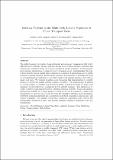| dc.contributor.author | Koutsopoulos, Haris N. | |
| dc.contributor.author | Goulet-Langlois, Gabriel Etienne | |
| dc.contributor.author | Zhao, Jinhua | |
| dc.date.accessioned | 2018-06-06T13:36:26Z | |
| dc.date.available | 2018-06-06T13:36:26Z | |
| dc.date.issued | 2016-02 | |
| dc.date.submitted | 2015-12 | |
| dc.identifier.issn | 0968-090X | |
| dc.identifier.uri | http://hdl.handle.net/1721.1/116133 | |
| dc.description.abstract | The public transport networks of dense cities such as London serve passengers with widely different travel patterns. In line with the diverse lives of urban dwellers, activities and journeys are combined within days and across days in diverse sequences. From personalized customer information, to improved travel demand models, understanding this type of heterogeneity among transit users is relevant to a number of applications core to public transport agencies’ function. In this study, passenger heterogeneity is investigated based on a longitudinal representation of each user’s multi-week activity sequence derived from smart card data. We propose a methodology leveraging this representation to identify clusters of users with similar activity sequence structure. The methodology is applied to a large sample (n = 33,026) from London’s public transport network, in which each passenger is represented by a continuous 4-week activity sequence. The application reveals 11 clusters, each characterized by a distinct sequence structure. Socio-demographic information available for a small sample of users (n = 1973) is combined to smart card transactions to analyze associations between the identified patterns and demographic attributes including passenger age, occupation, household composition and income, and vehicle ownership. The analysis reveals that significant connections exist between the demographic attributes of users and activity patterns identified exclusively from fare transactions. Keywords: Travel behavior, Smart card data, Activity sequence, User clustering, Public transportation, Data mining | en_US |
| dc.language.iso | en_US | |
| dc.publisher | Elsevier | en_US |
| dc.relation.isversionof | http://dx.doi.org/10.1016/j.trc.2015.12.012 | en_US |
| dc.rights | Creative Commons Attribution-NonCommercial-NoDerivs License | en_US |
| dc.rights.uri | http://creativecommons.org/licenses/by-nc-nd/4.0/ | en_US |
| dc.source | Prof. Zhou | en_US |
| dc.title | Inferring patterns in the multi-week activity sequences of public transport users | en_US |
| dc.type | Article | en_US |
| dc.identifier.citation | Goulet-Langlois, Gabriel, et al. “Inferring Patterns in the Multi-Week Activity Sequences of Public Transport Users.” Transportation Research Part C: Emerging Technologies, vol. 64, Mar. 2016, pp. 1–16. | en_US |
| dc.contributor.department | Massachusetts Institute of Technology. Department of Civil and Environmental Engineering | en_US |
| dc.contributor.department | Massachusetts Institute of Technology. Department of Urban Studies and Planning | en_US |
| dc.contributor.mitauthor | Goulet-Langlois, Gabriel Etienne | |
| dc.contributor.mitauthor | Zhao, Jinhua | |
| dc.relation.journal | Transportation Research Part C: Emerging Technologies | en_US |
| dc.eprint.version | Original manuscript | en_US |
| dc.type.uri | http://purl.org/eprint/type/JournalArticle | en_US |
| eprint.status | http://purl.org/eprint/status/NonPeerReviewed | en_US |
| dspace.orderedauthors | Goulet-Langlois, Gabriel; Koutsopoulos, Haris N.; Zhao, Jinhua | en_US |
| dspace.embargo.terms | N | en_US |
| dc.identifier.orcid | https://orcid.org/0000-0002-1929-7583 | |
| mit.license | PUBLISHER_CC | en_US |
